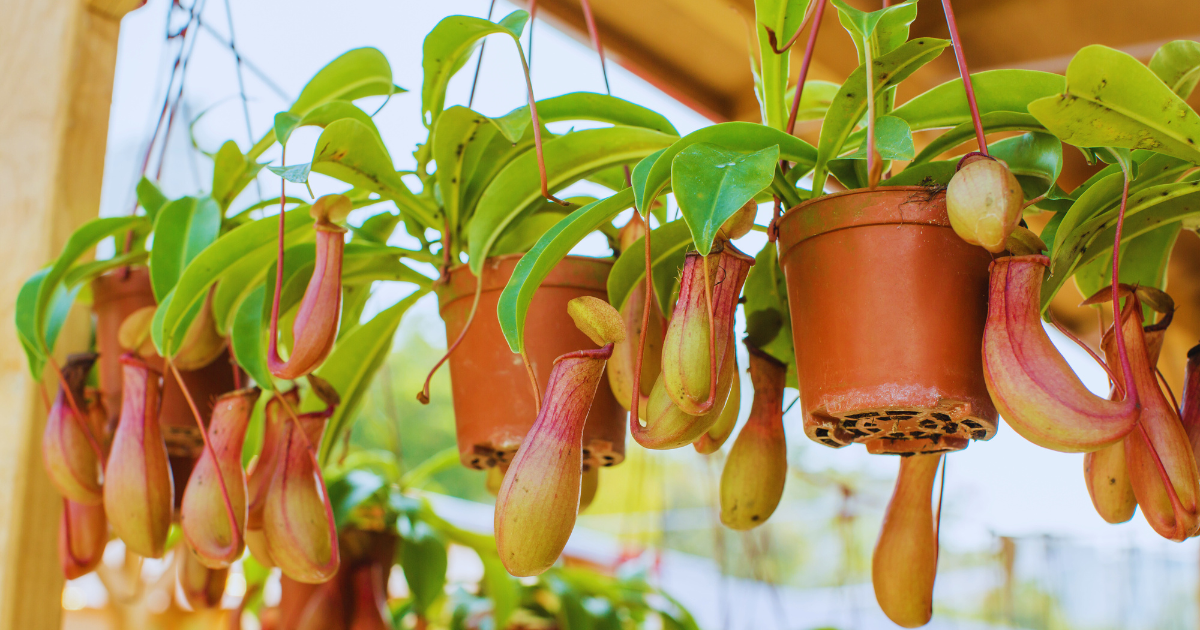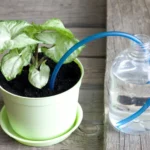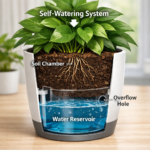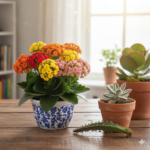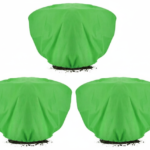The pitcher plant is a fascinating carnivorous species that captures and digests insects, offering a unique addition to any plant collection. While its exotic appearance may seem intimidating, caring for this beautiful plant is easier than you might think. This guide will explore essential tips for keeping your pitcher plant healthy and thriving. From understanding its specific light and water needs to ensuring proper humidity and soil conditions, we’ll help you create the perfect environment for your pitcher plant to flourish. Let’s dive in!
About Pitcher plants

Pitcher plants are among the most captivating and unique members of the plant kingdom, known for their remarkable ability to capture and digest insects. These carnivorous plants have evolved specialized leaf structures that form bottomless, tubular “pitchers,” which lure prey with nectar and bright colors. Once an insect slips inside, the plant’s slippery interior and digestive fluids trap and break it down, allowing the pitcher plant to absorb valuable nutrients often scarce in natural, nutrient-poor environments such as bogs and wetlands. This extraordinary adaptation sets pitcher plants apart, making them as beautiful and functional as nature’s insect hunters.
What Are Pitcher Plants?
Pitcher plants are a group of carnivorous plants known for their tube-shaped leaves, or “pitchers,” which act as traps for insects and other small prey. These plants use a combination of nectar, vibrant colors, and scents to lure insects into their pitchers. Once inside, the insects become trapped by the plant’s slippery walls and eventually drown in the digestive fluids at the bottom of the pitcher. The plant then absorbs the nutrients from the decomposing prey, which helps supplement its growth in nutrient-poor environments like bogs and wetlands. Pitcher plants are found in various regions, including North America, Southeast Asia, and Australia, and they come in several species, each adapted to their unique habitats.
Different Types of Pitcher Plants
There are several pitcher plants, each with unique characteristics and adapted to different environments. The two main groups of pitcher plants are Old World and New World species:
Nepenthes (Tropical Pitcher Plants)
- Region: Native to Southeast Asia, Madagascar, and parts of Australia.
- Description: These plants typically grow in tropical climates and produce long tendrils with large, often colorful pitchers at the ends. They can be found both in the ground and climbing trees.
- Unique Traits: Nepenthes can produce two types of pitchers—upper and lower—depending on their growth stage. The lower pitchers are generally larger and sit closer to the ground, while the upper ones are smaller and adapted for catching airborne prey.
Sarracenia (North American Pitcher Plants)
- Region: Primarily found in the southeastern United States, particularly in boggy areas.
- Description: Sarracenia plants have tall, slender, tubular pitchers that rise directly from the ground. These pitchers vary in color, often showcasing reds, greens, and purples.
- Unique Traits: Sarracenia pitchers attract prey with nectar, and once insects fall inside, they cannot escape due to downward-facing hairs and a slippery surface.
Darlingtonia (Cobra Lily)
- Region: Native to the Pacific Northwest of the United States, particularly California and Oregon.
- Description: Darlingtonia, or cobra lilies, are named for their snake-like appearance. Their pitchers have a unique hooded shape with fangs, which makes them look like a cobra ready to strike.
- Unique Traits: Unlike most pitcher plants, Darlingtonia pitchers use cool water from the soil to create an environment conducive to digesting prey.
Heliamphora (Sun Pitcher Plants)
- Region: Found in the highlands of South America, particularly in Venezuela and Guyana.
- Description: Heliamphora plants grow in extremely nutrient-poor environments and have upright pitchers that often remain partially filled with rainwater.
- Unique Traits: These pitchers tend to be more straightforward in structure than other types and rely on bacteria within the water to help break down prey.
Cephalotus (Australian Pitcher Plant)
- Region: Native to southwestern Australia.
- Description: Cephalotus plants produce minor, ground-level pitchers that are strikingly similar in appearance to Nepenthes, though they are unrelated.
- Unique Traits: Their compact, hairy pitchers have a unique hinged lid that helps keep rainwater from diluting the digestive juices inside.
Natural Habitat and Behavior
Pitcher plants naturally thrive in nutrient-poor environments, such as bogs, swamps, and wetlands, where the soil lacks essential nutrients like nitrogen and phosphorus. These harsh conditions have driven pitcher plants to evolve a unique method of survival: carnivory. By trapping and digesting insects, they obtain the nutrients the soil cannot provide. Their ability to thrive in waterlogged, acidic conditions where other plants struggle highlights their remarkable adaptability.
Pitcher plants are typically found in areas with high humidity, abundant sunlight, and moist, boggy soil. For example, Nepenthes are native to tropical rainforests in Southeast Asia and thrive in warm, humid conditions, often climbing trees to reach sunlight. In contrast, Sarracenia species in North America grow in open, sunny bogs and marshes.
In their natural habitat, pitcher plants have developed fascinating behaviors to catch prey. They attract insects with sweet-smelling nectar and vibrant colors. Once an insect enters the pitcher, the plant’s slippery walls and downward-pointing hairs prevent it from escaping. The insect eventually falls into the digestive fluid at the bottom of the pitcher, breaking it down into nutrients that the plant absorbs.
Despite their predatory nature, pitcher plants also play an important ecological role. They provide a habitat for certain species of insects, such as mosquito larvae and other tiny organisms that have adapted to live within the pitchers, creating a unique micro-ecosystem.
Choosing the Right Pitcher Plant

When choosing the right pitcher plant, you must consider your environment, care abilities, and the specific needs of different species. Here are some factors to help guide your decision:
Climate
- Tropical Environments: If you live in a warm, humid area or can provide these conditions indoors, a Nepenthes (Tropical Pitcher Plant) is a great choice. They thrive in temperatures between 70-85°F (21-29°C) and require high humidity levels.
- Temperate Climates: Sarracenia (North American Pitcher Plants) are more suitable for cooler or seasonal climates. They can handle temperature fluctuations and require a dormant period in winter, making them ideal for outdoor planting in certain regions.
Space and Placement
- Large, Climbing Plants: Nepenthes are known for their sprawling growth and climbing vines if you have ample space or plan to grow the plant outdoors. They require room to spread and can be kept in hanging baskets or tall pots.
- Compact Growth: Cephalotus (Australian Pitcher Plant) or certain Sarracenia species with more compact growth habits are excellent options for smaller spaces or indoor environments. These plants can fit in smaller pots or terrariums and are easier to manage.
Care Level
- Low-Maintenance: Sarracenia are generally easier to care for and more resilient to changes in temperature and light, making them suitable for beginners or those with less time for plant care.
- Advanced Care: Nepenthes and Heliamphora (Sun Pitcher Plants) may require more attention to humidity, light, and feeding schedules. These are better for experienced growers who can dedicate time to their needs.
Appearance
- Vibrant Colors: If you’re looking for visually striking plants, Sarracenia offers a variety of colors, from deep reds to purples and greens, while Nepenthes pitchers come in an array of vibrant shades and shapes.
- Unique Shapes: Consider Darlingtonia (Cobra Lily) with its snake-like pitchers or Cephalotus with small, intricate traps for unusual aesthetics.
Indoor vs. Outdoor
- Indoor Growth: Choose Nepenthes for indoor growing under controlled humidity and lighting conditions. They perform well in terrariums or on windowsills with filtered light.
- Outdoor Growth: Sarracenia and Darlingtonia are better suited for outdoor planting in bog gardens or pots on sunny patios, especially in temperate regions.
Read to know more: Fiskars House Plant Tool Set Review: Perfect for Indoor Gardeners
Ideal Growing Conditions
Light Requirements
Pitcher plants need plenty of light to thrive. Most species do best with bright, indirect sunlight. Ideally, they should receive about 6-8 hours of sunlight daily. If you’re growing your pitcher plant indoors, placing it near a south-facing window or using a grow light can help provide the necessary light levels. Insufficient light can lead to weak growth and fewer pitchers, so ensuring your plant gets enough light is essential.
Temperature and Humidity Needs
Pitcher plants prefer warm temperatures and high humidity, mimicking their natural tropical or subtropical habitats. For tropical species like Nepenthes, daytime temperatures should range from 70-85°F (21-29°C), with nighttime temperatures slightly more relaxed. Humidity levels should be kept high, ideally between 50-70%. This can be achieved by placing a humidity tray filled with water near the plant, misting it regularly, or using a humidifier.
Soil and Potting Mix
Pitcher plants require a nutrient-poor, well-draining soil mix that mimics their native boggy environments. A typical mix includes equal parts of sphagnum moss, perlite, and sand. Avoid using regular potting soil, as it contains too many nutrients and can harm the plant. The soil should remain moist but not waterlogged, as pitcher plants are sensitive to root rot.
Watering Needs
Water quality is crucial for pitcher plants, as they are susceptible to minerals and chemicals found in tap water. Always moisten the soil by using distilled water, rainwater, or reverse osmosis water. Water the plant by filling its tray with about an inch of water, allowing it to absorb what it needs. Ensure the soil never dries out completely, but avoid letting the plant sit in water for too long to prevent root rot.
Common Feeding Mistakes
Feeding a pitcher plant may seem simple, but it’s easy to make mistakes that can harm the plant. Here are some common feeding mistakes to avoid:
- Overfeeding: Adding too many insects or feeding too frequently can overwhelm the plant, leading to rot and decay inside the pitchers. Stick to feeding small amounts, especially if the plant is already catching insects.
- Feeding Non-Prey Items: Never feed your pitcher plant meat, processed food, or anything it wouldn’t naturally encounter in the wild. These items can cause bacterial growth and damage the plant’s health.
- Using Fertilizers: Pitcher plants thrive in nutrient-poor environments, so adding fertilizers to the soil or pitchers is harmful. Fertilizers can burn the plant and disrupt its delicate balance.
- Feeding Dead Insects: Avoid feeding your plant dead insects. Pitcher plants rely on the movement of live prey to trigger digestive enzymes. Without this, the plant may not properly digest its food.
- Feeding During Dormancy: In winter, many pitcher plants enter a dormant phase and stop actively growing. Feeding them during this time can stress the plants and interrupt their natural cycle.
How to Feed Your Pitcher Plant
Feeding your pitcher plant is a straightforward process, but it requires some attention to ensure it remains healthy and thrives. Here’s a guide on how to properly feed your pitcher plant:
Choose Appropriate Food
- Insects: Pitcher plants are carnivorous and naturally feed on insects. Small flies, ants, and spiders are ideal. If growing indoors, you can occasionally use live insects or pre-killed ones (if live prey isn’t available).
- Avoid: Do not feed them meat, dairy, or processed foods. These can cause health issues and attract harmful bacteria.
Feed in Moderation
- Frequency: Offer food every 2-3 weeks during the growing season (spring and summer). Overfeeding can lead to pitcher rot and other issues.
- Amount: Place 1-2 small insects per pitcher. Ensure that each pitcher gets only a tiny amount of food to avoid overloading.
Proper Feeding Techniques
- Live vs. Dead Insects: Live insects are best because their movement stimulates the pitcher to produce digestive enzymes. If using dead insects, ensure they are small and crushed to aid digestion.
- Placement: Gently place the insects at the opening of the pitcher. Avoid touching the plant’s interior, which can damage the delicate structure.
Monitor and Maintain
- Check Pitchers: Regularly inspect the pitchers to ensure they are clean and free from mould or rot. Remove any decayed food promptly.
- Adjust Feeding: During the plant’s dormant period (usually winter), reduce or stop feeding as the plant’s digestive activity slows down.
Common Problems and Solutions

Yellowing Leaves
Yellowing leaves are a common issue with pitcher plants and can be caused by several factors. The most frequent cause is overwatering or using tap water, which contains minerals that pitcher plants cannot tolerate. Ensure you’re using distilled, rain, or reverse osmosis water. Another possible cause is insufficient light, as pitcher plants need bright, indirect sunlight for at least 6-8 hours daily. Check that your plant gets adequate light and adjust its location if necessary.
Pitchers Not Forming
If your pitcher plant isn’t forming new pitchers, it’s likely due to a lack of light or improper feeding. Pitcher plants need plenty of light to produce pitchers, so ensure they receive enough sunlight or supplemental lighting. Another reason could be a lack of nutrients from insects. Although pitcher plants don’t need to be fed frequently, they require occasional feeding with small insects to maintain nutrient levels. Avoid using fertilizer, as it can damage the plant.
Brown or Dry Pitcher Edges
Browning or dry edges on pitchers can be caused by low humidity, insufficient watering, or excessive exposure to direct sunlight. Pitcher plants thrive in high humidity, so increase humidity levels by misting the plant regularly or using a humidity tray. Ensure the plant is consistently watered with the right type of water and adjust its position to prevent it from getting too much direct sunlight, which can scorch the delicate pitchers.
Pests and Diseases
While pitcher plants naturally control most pests due to their predatory nature, they can occasionally suffer from aphid, mealybug, or spider mite infestations. To combat pests, use insecticidal soap or neem oil and thoroughly coat the affected areas without letting the solution pool inside the pitchers. For less common fungal infections, improve air circulation around the plant and reduce humidity slightly until the issue is resolved.
Mold and Algae Growth
Mold and algae can grow on the soil’s surface, especially if conditions are too wet and there’s poor air circulation. To prevent this, make sure the soil is well-draining and not waterlogged. Algae can be controlled by reducing the amount of light on the soil surface, and mold can be managed by removing any dead plant material and ensuring good air movement around the plant.
Slow Growth or Dormancy Concerns
Some pitcher plants, mainly temperate species like Sarracenia, naturally enter a dormancy period during winter. Growth will slow down significantly during this time, and some leaves may die back. This is a normal part of their life cycle. However, if a tropical pitcher plant appears to be slowing down during the growing season, it could be due to stress from environmental changes, such as temperature fluctuations, inadequate light, or improper watering. Evaluate the growing conditions and make necessary adjustments.
Conclusion
Caring for a pitcher plant can be an exciting and rewarding experience, especially when you see it thriving and catching insects. These unique and beautiful plants require specific growing conditions, including proper light, water, humidity, and soil. By understanding and meeting these needs, you can ensure your pitcher plant remains healthy and continues to grow vibrant pitchers. Remember, the key to success is to mimic their natural habitat as closely as possible and don’t be afraid to make adjustments based on your plant’s response. With the proper care, your pitcher plant will be a striking addition to your collection.
FAQs
How often should I water my pitcher plant?
Water your pitcher plant regularly to keep the soil consistently moist but not waterlogged. Typically, you should check the moisture level of the soil every few days and water whenever the top feels dry. To avoid mineral buildup, it’s best to use distilled, rain, or reverse osmosis water.
Can I feed my pitcher plant insects from my garden?
You can feed your pitcher plant insects from your garden, such as ants, flies, or small crickets. Just ensure the insects are small enough to fit into the pitchers and are pesticide-free. Feeding is unnecessary and optional if your plant is outdoors and already catching insects on its own.
Why are my pitcher plant’s leaves turning brown?
Brown leaves on a pitcher plant can be caused by several factors, including low humidity, insufficient water, or too much direct sunlight. Ensure your plant gets enough moisture and water, and try to provide bright, indirect light instead of direct sunlight that can scorch the leaves.
Do pitcher plants need fertilizer?
Pitcher plants do not need fertilizer and can be harmed by it. They get all the nutrients they need from the insects they capture. Fertilizers contain minerals that can damage the roots and alter the soil conditions, so it’s best to stick to natural feeding methods with insects.
How do I know if my pitcher plant is healthy?
A healthy pitcher plant will have vibrant green leaves and regularly produce new pitchers. The pitchers should be firm, colorful, and actively capturing insects. If your plant is producing new growth and the pitchers are functional, it’s a good sign that your plant is in good health.

